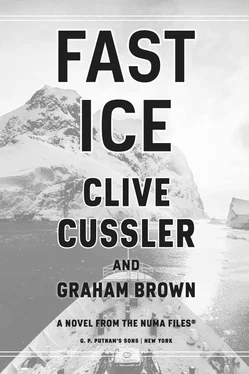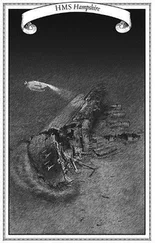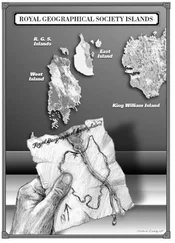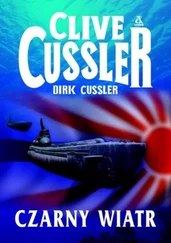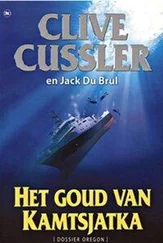They still had eighty miles to go. The computer, though, calculated a maximum range of about sixty. While the tailwind had helped tremendously, they were still looking at landing a little short.
“Think we can stretch it?” Kurt asked.
“It’s going to be close. May have to put us down a few miles from our hotel.”
Kurt picked up a tablet computer that was connected to the aircraft’s navigation system. “I’ll look for a nice flat spot, should we need it.”
Zooming in on the final target zone, Kurt scanned for flat terrain. The standard database had only limited elevation measurements. Rudi and Hiram had downloaded the information from the Navy flyover, which was hyperdetailed.
“Bless you, Rudi,” Kurt said.
Working in five-mile increments, Kurt earmarked three different spots that would be promising landing zones for the helicopter when it ran out of gas.
“Don’t suppose this thing is like my old Mazda?” Kurt asked. “Where empty means you can still go thirty miles?”
“Doubt it,” Joe said. “Never took the chance to find out, though. The wind has helped us a lot but it’s fading as we get farther away from the center of the storm.”
As Joe finished speaking, the Jayhawk began to talk. “Low fuel,” the computer announced. “Low fuel.”
The message repeated itself over and over until Joe found the button to silence the alarm. Even then, the warning lights continued to flash on the panel.
Fifteen minutes later, the computer began to talk again. “ Fuel critical . . . Fuel critical . . . Fuel critical . . .”
As Joe silenced the new alarm, Kurt glanced at the estimated range. It was ten miles. Less than five minutes of flight time.
“We need an off-ramp,” Joe said calmly. “What have you got?”
“Exit 101 coming up,” Kurt said.
He tapped the location on his touch screen and Joe entered it into his navigation computer.
Joe took a quick look and changed course. He cut the power and began to descend. Lower and slower, they experienced less turbulence, but the tension rose.
“We’re getting a local headwind here,” Joe said. “Air currents getting deflected off the peaks to the east of us.”
“Is that going to be a problem?”
“Definitely,” Joe said. “We’re going to run out of fuel fast.”
Kurt could see from the GPS indicator that their ground speed had fallen substantially while the fuel consumption was the same.
Joe was forced to add power. The moment he did, a whole panel of warning lights came on one after the other. An audible alarm began overhead. The engines were cutting out, rpm dropping.
“Definitely not like your Mazda,” Joe said.
He aimed the nose of the helicopter downward, adjusting the pitch of the blades to keep them spinning, the helicopter’s method for gliding called autorotation.
Kurt was thankful that they weren’t dropping out of the sky like a brick, yet they seemed at the mercy of the wind. He gazed at the needle on the altimeter. It crossed below five thousand feet and then, after another quick lap, dropped below four thousand.
Kurt looked at the computer tablet with the ground information. The elevation was listed as 2,134.
Joe banked the helicopter just as a furious gust hit. It threatened to roll them over, but Joe countered it.
“Terrain, pull up,” the computer warned. “Terrain, pull up.”
Kurt noticed they were below three thousand feet now.
“Do me a favor,” Joe said. “When we go below twenty-five hundred feet, turn on the landing lights so we can see what’s below us.”
“What if it doesn’t look good?” Kurt asked.
“Then you turn the lights off again.”
Kurt put his finger on the switch. They’d been flying in blackout mode with all the exterior lights off, but Joe would need a brief glimpse of the ground to land them safely. It offered a minuscule risk of detection, but Kurt doubted anyone would be watching the sky in the middle of a blizzard. Not ten miles from the pumping station.
The altimeter dropped below twenty-five hundred. Kurt flipped the switch.
A pair of high-intensity lights came on underneath the nose. They blazed into the night, but all that could be seen was storm-driven snow whipping past the helicopter. Joe slowed the craft further and turned directly into the flow of the wind.
According to the computer, the ground was coming up fast. Kurt could see nothing. “Two hundred feet to the ground,” he called out. “One hundred and fifty.”
It felt like a sped-up version of feeling for the bottom on a deep-sea dive. Where you could see nothing yet knew it was coming up fast.
The helicopter continued to drop, swinging wildly in the gusts.
“One hundred feet,” Kurt said.
A field of volcanic rock emerged from the gloom, dark brown against the white background. It helped with the depth perception. Joe still had to change course to avoid hitting the upward-thrusting formations.
He dodged them and aimed the helicopter toward a field of snow. The ground seemed to rush up at them. Joe flared the helicopter at the last moment, bringing the nose up like a regular airplane just above the runway.
Kurt noticed that Joe hadn’t put the landing gear down. He kept that to himself.
The ground turned blindingly bright as they approached. It darkened suddenly as the Jayhawk plowed into the snow and the lights were buried beneath it. The impact was jarring but not disastrous. The flat bottom of the helicopter took the shock and spread it out like the underside of a boat. They slid forward, losing speed quickly and coming to a stop.
Kurt was leaning forward, his shoulders held tight in the straps of the safety harness. The only sound he heard was the wind whipping past and a strange ticking that came from somewhere above them as the rotors continued churning with built-up inertia.
Incredibly, the landing lights under the nose of the helicopter continued to function. Though they were now buried, they managed to spread a soft glow through the translucent snow around its base.
Joe shut everything down except the lights. That done, he removed his helmet. “You’re now free to move about Antarctica.”
“Thank God, we’re on the ground,” Gamay said. Her first words in three hours. “I am never flying with you again.”
“Great landing,” Kurt said. “Now all we have to do is cross ten miles of forbidding terrain while fighting through a blizzard.”
From the back of the helicopter, Paul laughed. “At least the hard part is over.”
After pulling on their cold-weather gear, including insulated versions of the expedition jackets, they stepped from the helicopter and unloaded the snowmobiles.
Kurt, Joe and Gamay donned heated gloves, triple-insulated ski caps, neck gaiters that pulled up and covered their faces and insulated goggles to protect their eyes.
Paul had chosen a balaclava, ski goggles and an oversize fur hat with earflaps. He pulled it down tight and secured it with a strap under his chin.
Gamay shook her head at his fashion choice. “I thought you said those hats were Communist propaganda?”
“This one is Canadian,” Paul said. “And it’s incredibly warm.”
Kurt glanced at Paul, who looked ridiculous. But considering the cold was already biting at Kurt’s ears despite the modern material of his own hat, he guessed Paul would have the last laugh on that one. “Let’s get the explosives loaded and get moving.”
45
BASE ZERO, HOLTZMAN GLACIER
Yvonne Lloyd sat on a folding canvas chair in the dimly lit control dome of Base Zero. A pair of ruggedized laptop computers sat on a table in front of her. They were field units, with protective rubber cases, waterproof keyboards and heavy battery packs that could power them for several days if need be.
Читать дальше
